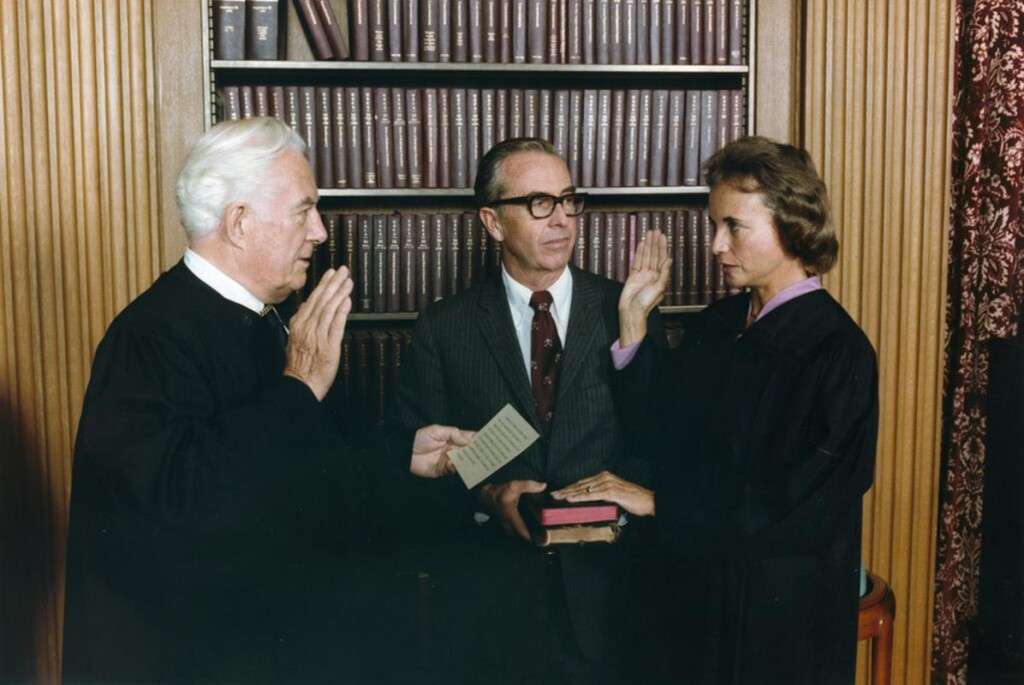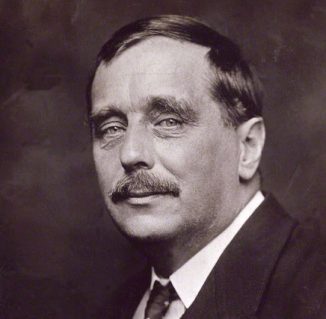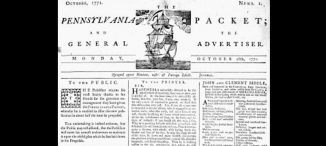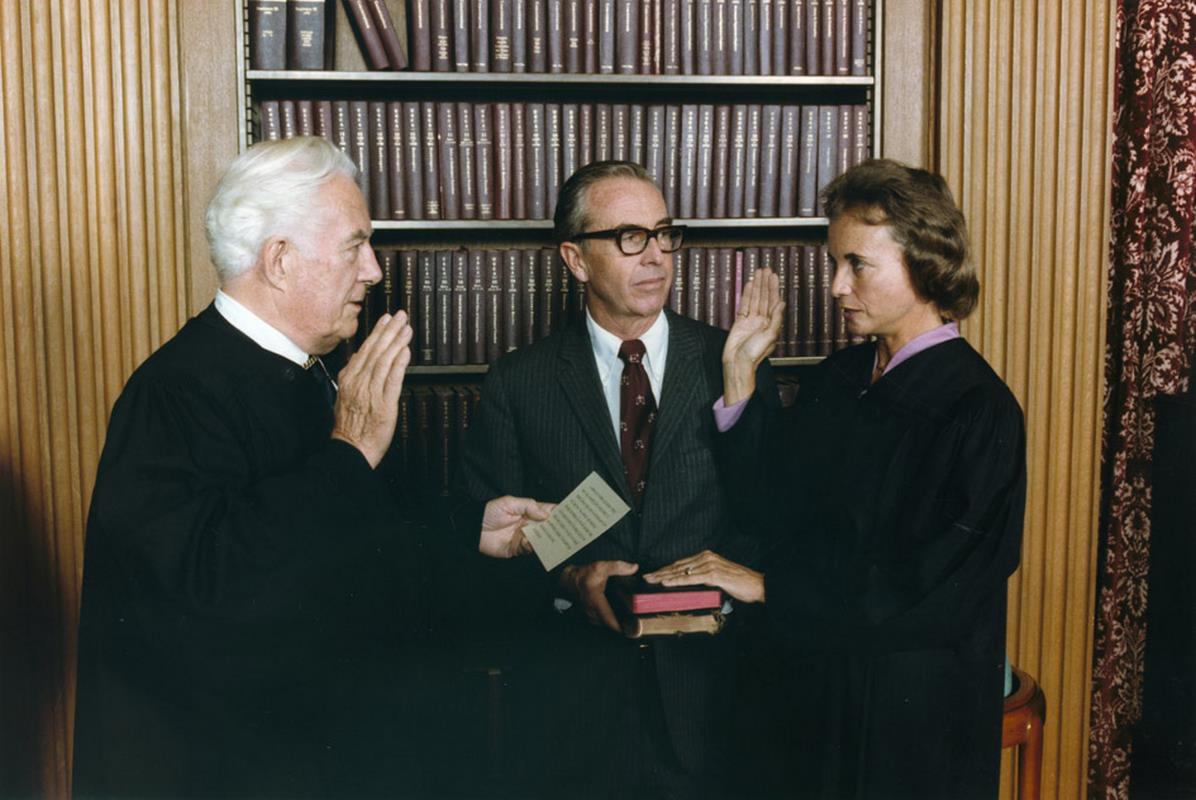43 years ago today, Sandra Day O’Connor was sworn in as the first female Supreme Court Justice. She was approved in the Senate 99-0, with one Montana Senator being absent from who vote, who later sent her a copy of A River Runs Through It, by way of an apology. In her first year on the Court, she received over 60,000 letters from the public, more than any other justice in history. READ more about this famous justice… (1981)

No justice has universal approval from anyone, even those who support them. So it’s rare that a justice will have a legacy that can be easily summarized with positivity. O’Connor received plenty of criticism throughout her career, on her voting tendencies, and after her retirement.
Voting initially as a Reagenite, the years saw her gradually move into a position of centrism that neither ignited approval from the liberal justices nor satisfied right-wing commentators and politicians who often looked toward her for votes along their philosophy.
One particular decision for which she was applauded was her 1983 opinion on whether drug-sniffing dogs violated Fourth Amendment protections. She wrote that “needless humiliation of an individual is an important factor in determining Fourth Amendment reasonableness,” although she eventually upheld the obvious unconstitutionality of it.
MORE Good News on this Day:
- The Yes, Virginia, there is a Santa Claus letter was published in the New York Sun answering the question from 8-year-old Virginia O’Hanlon (1897)
- Independence Day in Malta, from Britain (1964); Belize, from Britain (1981); and Armenia, from the Soviet Union (1991)
- America: A Tribute to Heroes was broadcast by over 35 network and cable channels, raising over $200 million for victims of the September 11 attacks (2001)
- Today is the United Nations’ International Day of Peace
On this day in 1915, a Mr. Cecil Chubbs bought Stonehenge for £6,600. Born in Shrewton, four miles west of the iconic Neolithic monument, he had grown up passing by the Salisbury Plain and admiring it and believed after amassing a personal fortune, that a “Salisbury man” ought to be the owner. Three years after his purchase, he presented it as a gift to Great Britain’s first Commissioner of Works, who received it on behalf of the nation.

Since the early 16th century, Stonehenge has been privately owned. The first proprietors were the Nuns of Amesbury Abbey, and it passed from blueblooded family to blueblooded family. The Antrobus Family bought the Stonehenge estate in 1824, but after the death of family head Edmund Antrobus, his son decided to sell it.
“Lot 15. Stonehenge with about 30 acres, 2 rods, 37 perches of adjoining downland,” read a land auction entry. Cecil Chubbs grew up among humble beginnings but made a small fortune by taking over his father-in-law’s management of Old Manor Hospital, as well as through horse racing and cattle breeding.
It was his interest in Stonehenge as a local boy that led him to attend the sale. He had no intention of bidding “but while I was in the room I thought a Salisbury man ought to buy it and that is how it was done”. He remained its owner for three years and then, on October the 26th 1918, he formally handed it over to Sir Alfred Mond the First Commissioner of Works, who received it as a gift on behalf of the nation.
By that time, Stonehenge was a popular attraction, and the ticket sales of about £360 a year, were a lucrative loss. Cecil conditioned the gift by saying that the money should go to the Red Cross for the rest of the war. The second was that there should be free admission during normal opening hours for the residents of Shrewton (his native parish), Netheravon (his father’s birthplace), Durrington (whence his mother came), and Amesbury in which parish Stonehenge stands. This privilege was later widened to include all the parishes of the former Amesbury Rural District and is still in force today. (1915)
87 years ago today, J.R.R. Tolkien’s The Hobbit, or ‘There and Back Again’, was first published to wide critical acclaim in London. A linguist and scholar of Anglo-Saxon and German literature at Oxford, Tolkien wrote The Hobbit so he had something marvelous to read to his young children, but upon its publication so many letters arrived from readers wishing to continue exploring Tolkien’s “Middle Earth” that he slowly built up the manuscripts over the dark years before, during, and after World War II, and arrived at the masterful trilogy The Lord of the Rings, which together have sold more copies than almost any other book in history.

The Hobbit, set in a time of elves and wizards, follows the quest of a hobbit, Bilbo Baggins, along with 13 dwarves, to win back a stolen treasure guarded by a fierce dragon. Bilbo’s adventure leads him from his light-hearted, rural homeland on a true Hero’s Journey—and back, again. In 2012, the book became a series of films starring Martin Freeman and Iain McKellen.
C. S. Lewis, a friend of Tolkien, reviewed The Hobbit in the Times of London. “The truth is that in this book a number of good things, never before united, have come together: a fund of humor, an understanding of children, and a happy fusion of the scholar’s with the poet’s grasp of mythology… The professor has the air of inventing nothing. He has studied trolls and dragons at first hand and describes them with that fidelity that is worth oceans of glib “originality.”
And, 158 years ago today, the prolific British writer and thinker HG Wells was born. An accident in his young life that left him bedridden with a broken leg was the spark that fanned Herbert George’s love of books and stimulated his desire to write.
Sometimes called The Father of Science Fiction, he wrote The Time Machine, when he was 29 years old, and also authored The Invisible Man, and The War of the Worlds. But Wells, a trained scientist, wrote in many genres, including novels, history, politics, social commentary, and textbooks, His frequent focus on class inequality made him a worthy successor to Charles Dickens.
Wells, whose religious views were neither monotheistic nor doctrinaire, was disdainful of America for not allowing African Americans to vote and for the overall treatment they received from society. In his later years, he apologized for earlier statements opposing the Jewish state and Zionist movement—partly because it was so antithetical to his vision of a collective socialist solidarity and “one world” political model. A diabetic, Wells co-founded the charity Diabetes UK, before his death from the disease at age 79. (1866)

Happy 77th Birthday to author Stephen King, whose 56 bestselling horror, science fiction, and suspense novels include Carrie, The Shining, The Stand, and Misery. Abandoned by his father when he was two, King spent his childhood poring over horror books, comic books, and films.
At age 26, before his first novel Carrie became a success, a discouraged King had thrown an early draft of the story into the trash, but his wife retrieved it and encouraged him to finish the manuscript. Currently, the new film, IT, is on track to pass The Exorcist as the highest-grossing horror film of all time.
King’s books have sold more than 350 million copies, and many have been adapted for films, including Shawshank Redemption. The prolific award-winning writer penned a memoir in 2000 called On Writing. His wife of 47 years, Tabitha, has written six novels, and both their sons are also published authors. His new book out this week is a collaboration with his son Owen, a story set in a women’s prison, entitled Sleeping Beauties: A Novel. (1947)

240 years ago today, The Pennsylvania Packet and Daily Advertiser became the first successful daily newspaper published in America. Exactly 12 years later, the paper was the first to publish George Washington’s Farewell Address. The publication was renamed several times and in 1825, Poulson’s Advertiser was granted an interview by the Marquis De Lafayette during his famous visit to the United States. The final successor of the Packet is said to be The Philadelphia Inquirer.
In 1962, The Inquirer laid claim to being “the oldest daily newspaper in the United States founded in 1771”—a line that appeared on the paper’s masthead for the next 13 years—after a local historian commissioned by the major morning paper laboriously constructed a “family tree” that purported to show that The Inquirer was the successor through a series of acquisitions to The Pennsylvania Packet and General Advertiser. (1784)
Happy 74th Birthday to the actor and comedian Bill Murray. A recipient of the Twain Prize for American Humor, Murray has become beloved not only for movies like Groundhog Day, Caddyshack (co-written by Murray’s brother), Scrooged, and Ghostbusters, but for his spontaneous interactions with unwitting fans on the street.

Bill’s philosophy of life is worth replicating, too: “I live a little bit on the seat of my pants, I try to be alert and available. I try to be available for life to happen to me. We’re in this life, and if you’re not available, the sort of ordinary time goes past and you didn’t live it. But if you’re available, life gets huge. You’re really living it.”
After finding fame as a cast member on Saturday Night Live, he later starred in Lost in Translation (2003), which earned him a Golden Globe and a British Academy Film Award, as well as an Oscar nomination for Best Actor. He received Golden Globe nominations for his roles in Ghostbusters, Rushmore (1998), Hyde Park on Hudson (2012), St. Vincent (2014), and the HBO miniseries Olive Kitteridge (2014), for which he later won his second Emmy Award. WATCH the 10 Most Awesome Real Life Bill Murray moments… (1950)
CHECK Out: Bill Murray Drives Taxi So Cabbie Can Practice Saxophone
Also, here’s a few Murray moments on film…
Share the Milestones, Memories, and Movies…





















[…] post Good News in History September 21 appeared first on The Good News […]